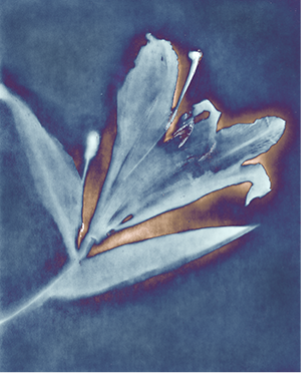Project Background
From its inception in 1839, photography has been a medium dependent on silver halide's sensitivity to light. The more light, either through duration or intensity, the darker in value the silver becomes. Some of the earliest photographs were camera-less. A botanical specimen was placed on silver based paper and exposed to light. When developed an image would appear. In traditional camera-based photography a piece of film with an emulsion of silver bromide is placed in the back of a camera. Light reflected off an object passes through the lens and leaves an image on the film by photon-induced reduction of silver ions. The image is made visible and permanent after the film is developed.
We have recently discovered that silver paper darkens by chemical reaction with ascorbic acid in the absence of light. Ascorbic acid, also known as vitamin C, is a reducing acid of considerable physiological and industrial importance. The reversible oxidation of ascorbic acid to dehydroascorbic acid by two-step, two-electron reaction is the likely basis for ascorbic acid's exposure of photographic paper. Our observation of photographic paper exposure by ascorbic acid has two exciting applications in art and engineering. First, the reaction could be used to chemically "paint" on photographic paper, enabling a new form of creative expression in the photographic arts. Second, if a relationship between ascorbic acid concentration and degree of exposure can be established, the reaction can also be used as the basis for a low-cost ascorbic acid sensor using photographic paper.
Student Role
Our goal for the summer is to establish a grayscale standard relating ascorbic acid concentration to degree of exposure of photographic paper. Commercially-available silver based photographic paper will be exposed to different concentrations of ascorbic acid with varying exposure time, solution volume, temperature, neutral salt concentration, and pH values. A design of experiments approach will be used to rapidly screen a large number of process variable combinations. By showing to what degree silver darkens under different ascorbic acid exposure conditions, we will establish a working palette for future artistic use. Simultaneously, we will quantify photographic paper limits-of-detection and sensitivity to ascorbic acid, and compare these values with consumer and industrial application requirements.
The undergraduate researcher will participate in all aspects of this work, including: reviewing relevant scientific research papers; developing a design of experiments framework for screening process conditions (with guidance from the research faculty); conducting lab work preparing ascorbic acid solutions and developing photographic paper samples in the dark room; measuring grayscale values of sample exposures; and analyzing/documenting results. A successful student will be someone who is detail-oriented and careful in the lab, takes good notes on their experiments, and has an analytical frame of mind. A typical day will involve time spent in the lab conducting experiments (~5-6 hours), time spent documenting and analyzing results for the day (~1-2 hours), and regular meetings with the research faculty. The student will be invited to participate in all general research and social activities of Prof. Warren's lab.
Student Learning Outcomes and Benefits
Through their work on this summer research project, the undergraduate student will learn how to:
- Design and execute a series of laboratory experiments;
- Develop photographic images in the dark room;
- Analyze research results;
- Document and/or present their results in the form of a research paper and/or presentation.
The project could be a good fit for a student interested in future research opportunities in science and engineering (e.g. MS-thesis or PhD research programs), or someone looking to develop their dark room skills to pursue graduate school or a career path in the visual arts (photography).

Roseanne Warren
The undergraduate researcher will be jointly mentored by Professor Roseanne Warren (Department of Mechanical Engineering) and Emeritus Professor Joe Marotta (Department of Art & Art History). The student will meet with Warren and/or Marotta on a regular basis throughout the summer.
Prof. Warren's first research experience was as an undergraduate student, and she strongly believes in the formative nature of this opportunity. Warren has mentored 17 undergraduate students during her six years as a faculty member. Many of these students have gone on to graduate school; three published journal articles as a first and/or second author. Warren believes that undergraduate researchers should be exposed to as many different aspects of research as possible. She encourages undergraduates to get to know the graduate students in the group, and observe experiments outside of their immediate project tasks. This includes work from Warren's group taking place in the University of Utah Nanofab and Electron Microscopy & Surface Analysis Lab.
Prof. Marotta started the photography emphasis in the Art and Art History Dept. in 1978 and was the head of the photography emphasis from1978 to 2014. As area head he guided curriculum development for digital and film based courses, counseling students, repairing and maintaining equipment, facility expansion, and scheduling darkroom and studio use. He has chaired one to two graduate student committees per year, as well as working with numerous graduate and undergraduate students independently and through courses.
